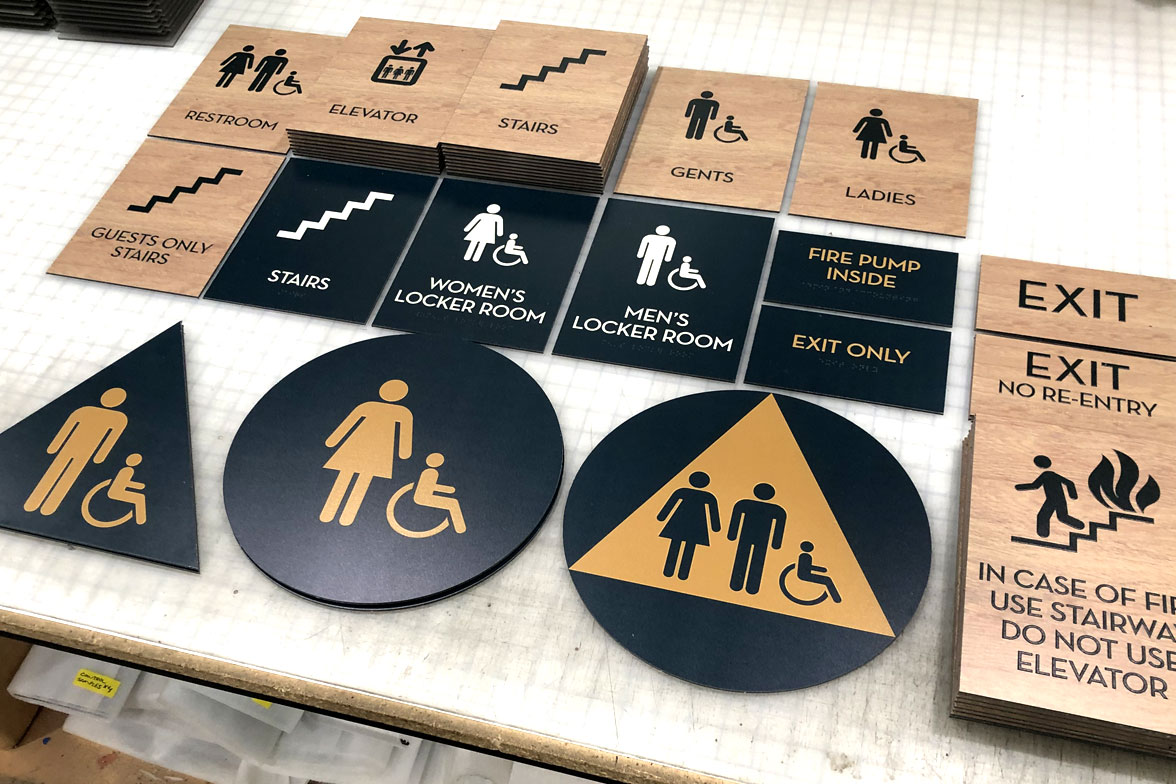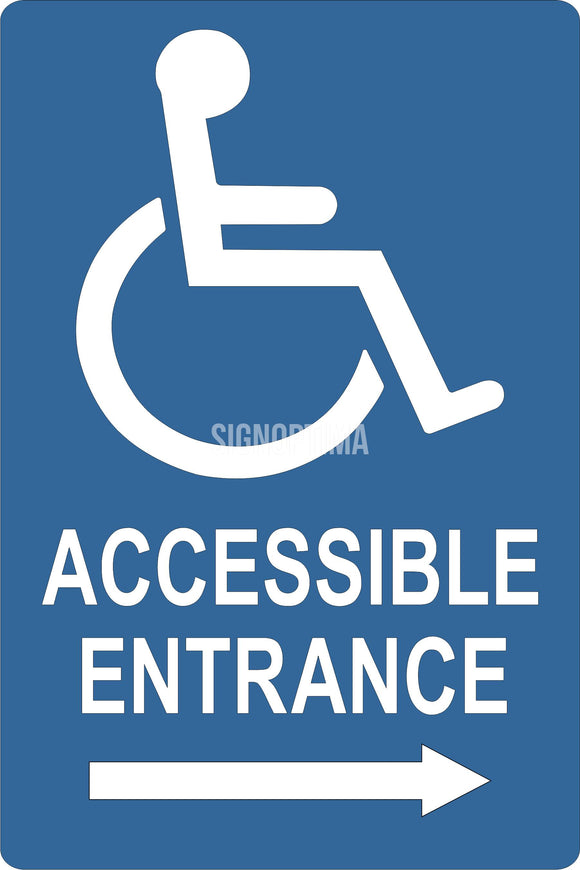The Advantages of Using High-Quality ADA Signs in Your Business
The Advantages of Using High-Quality ADA Signs in Your Business
Blog Article
ADA Signage: Making Certain Accessibility and Conformity in Public Spaces
ADA signage plays a crucial function in assuring ease of access and compliance within public spaces, significantly adding to an inclusive setting for people with disabilities. By adhering to ADA standards, signs not only promotes navigation yet likewise highlights a company's devotion to diversity and equal rights. As we check out the nuances of ADA signs, from responsive features to make intricacies, it's important to take into consideration exactly how these components coalesce to support the rights of all individuals. What are the common pitfalls companies deal with in preserving conformity, and how can future fads in signs continue to drive access onward?
Significance of ADA Signs
In modern culture, the value of ADA signage extends beyond simple conformity with lawful requireds to personify a dedication to inclusivity and accessibility for all people. These indicators are necessary in developing settings where individuals with disabilities can browse public spaces with the exact same ease and freedom as those without handicaps. By offering clear and standard information, ADA signage guarantees that everyone can access facilities, services, and details without barriers.
The value of ADA signage hinges on its capacity to enhance the lifestyle for individuals with impairments by advertising equivalent accessibility. It removes the challenges that could or else prevent their ability to participate fully in area life. These indicators offer as noticeable signs of a company's commitment to diversity and equal rights, reflecting more comprehensive social values that champion the legal rights and self-respect of all people.
Additionally, ADA signage plays an important duty in public security. By directing individuals to departures, toilets, and various other vital centers, it makes certain that all people, despite physical capacity, can evacuate securely during emergency situations. In summary, ADA signage is not simply a regulatory requirement yet a powerful device for cultivating a inclusive and fair culture.
Secret Aspects of Compliance

Positioning is crucial; indicators should be mounted in places that are quickly visible and obtainable. Usually, signage should be mounted in between 48 and 60 inches from the ground to make certain accessibility for both standing and mobility device individuals. Tactile aspects, such as Braille, are essential for people with visual problems, offering vital details in a non-visual format.
High-contrast colors in between the message and history are necessary to improve readability for people with reduced vision. The ADA mandates specific comparison proportions to ensure quality. In addition, personality size is a key factor to consider, with minimum height requirements dictated by the checking out range to guarantee readability from numerous angles.
Style Considerations for Ease Of Access
Creating easily accessible signs calls for a careful method to guarantee it fulfills the demands of all users, especially those with impairments. The size of the message is equally vital, with ADA guidelines advising a minimum height based on checking out range to guarantee legibility.
Contrasting shades in between message and history are crucial for presence, particularly for people with visual problems. In addition, responsive elements, such as Braille and raised characters, are crucial for individuals who are blind or have low vision.
Furthermore, the positioning of more tips here signs plays a substantial function in access. Indicators should be mounted in areas that are quickly obtainable and unobstructed. Guaranteeing that signage is installed at appropriate heights and angles makes it possible for all customers, including those using wheelchairs, to interact with them effectively.
Typical Blunders to Prevent

Another find this prevalent mistake is the wrong placement of signs. ADA guidelines define specific elevation and place needs to make sure that indications are quickly noticeable and reachable by all people, including those making use of wheelchairs. Neglecting these standards not only interferes with availability but likewise takes the chance of non-compliance with legal requirements.
In addition, not enough comparison between message and history is a regular oversight. Ample contrast is vital for readability, particularly for people with low vision. Developers occasionally choose shades that are visually enticing however do not have the needed comparison, making the text tough to discern.
Lastly, some designers stop working to include tactile elements, such as Braille, which are crucial for people who are blind. Leaving out these features not only leads to non-compliance with ADA regulations however likewise limits access for a sector of the populace that counts on tactile information.
Future Trends in Signs
Improvements in innovation and raising understanding of inclusivity are shaping the future patterns in signage design. As society comes to be much more conscious of diverse needs, the integration of wise technologies right into signs is gaining grip. Digital signage, for instance, is advancing to include real-time updates and interactive features, which can be vital in providing vibrant details in public spaces. These indications often integrate touch screens or gesture-based controls, enabling individuals to browse content tailored to their particular demands.
Another emerging trend is the usage of enhanced fact (AR) to boost customer experience. AR-enabled signage can overlay electronic info onto the physical setting, offering visually damaged individuals with auditory or haptic comments. ADA Signs. This modern technology not only enhances access but additionally Check This Out creates an appealing experience for all users
Sustainability is also a significant variable influencing signage patterns. Environmentally friendly products and energy-efficient lighting options are being prioritized to straighten with international ecological goals. Advancements in materials science are leading to the advancement of more weather-resistant and sturdy signs.
Final Thought
ADA signs plays a vital role in guaranteeing ease of access and compliance within public rooms by incorporating tactile aspects, high-contrast colors, and tactical placement. The adherence to ADA standards not just promotes safe navigation for people with impairments yet additionally indicates an organization's commitment to diversity and inclusivity. By preventing common mistakes and accepting future fads, public spaces can proceed to advance these values, ensuring that the civil liberties and self-respect of all individuals are respected and supported.
ADA signs plays an important role in guaranteeing access and compliance within public areas, significantly contributing to a comprehensive setting for people with handicaps. As we discover the nuances of ADA signage, from tactile features to develop complexities, it's vital to take into consideration how these aspects integrate to support the rights of all users.In modern-day culture, the value of ADA signage extends beyond mere compliance with lawful requireds to embody a commitment to inclusivity and access for all individuals. By providing clear and standard details, ADA signs makes certain that every person can access facilities, services, and information without barriers.
ADA signs plays an essential duty in guaranteeing access and conformity within public areas by incorporating responsive aspects, high-contrast shades, and calculated positioning. (ADA Signs)
Report this page